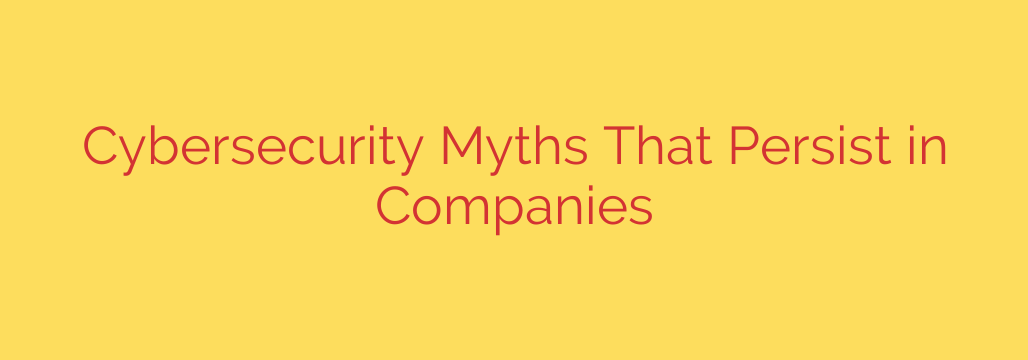
Is Your Business Truly Secure? Debunking 5 Dangerous Cybersecurity Myths
In today’s digital landscape, a single data breach can devastate a company’s finances, reputation, and customer trust. Yet, many organizations continue to operate under a false sense of security, guided by outdated assumptions and dangerous cybersecurity myths. Believing these misconceptions is like leaving the front door unlocked and hoping for the best.
Understanding the reality behind these common myths is the first step toward building a truly resilient security posture. Let’s dismantle the five most persistent cybersecurity myths that could be putting your business at critical risk.
Myth #1: “We’re Too Small to Be a Target”
This is perhaps the most dangerous myth circulating among small and medium-sized businesses (SMBs). The reality is that hackers don’t discriminate based on size; they look for easy targets. SMBs are often prime candidates because they typically have fewer security resources and less robust defenses than large corporations.
Cybercriminals use automated tools to scan the internet for vulnerabilities, and your business size is irrelevant to these bots. Furthermore, small businesses can be used as a stepping stone to attack larger partners in a supply chain attack. Cybercriminals often view small businesses as high-reward, low-risk targets due to their perceived lack of sophisticated security.
Actionable Tip: Every business, regardless of size, needs foundational security measures. Implement a strong firewall, ensure all software is regularly updated and patched, and maintain secure, isolated backups of your critical data.
Myth #2: “Cybersecurity Is Exclusively an IT Problem”
Assigning all security responsibility to the IT department is a critical strategic error. While the IT team manages the technical infrastructure, the vast majority of successful cyberattacks exploit human error. An employee clicking on a phishing link, using a weak password, or mishandling sensitive data can bypass even the most advanced technological defenses.
Cybersecurity is a collective responsibility that must be ingrained in your company culture. Every employee, from the C-suite to the front lines, is a part of your security perimeter and must be trained to recognize and respond to threats. A strong security posture requires a company-wide culture of awareness, not just a dedicated IT team.
Actionable Tip: Implement mandatory, ongoing security awareness training for all employees. This should include education on phishing, social engineering, password hygiene, and secure data handling practices.
Myth #3: “Basic Antivirus and a Firewall Are Sufficient Protection”
A decade ago, a standard antivirus program and a network firewall might have been enough. Today, they are merely the entry fee for basic security. Modern cyber threats, such as zero-day exploits, advanced persistent threats (APTs), and sophisticated ransomware, are designed specifically to evade these traditional defenses.
Relying solely on these tools leaves you vulnerable to a huge range of modern attacks. Effective cybersecurity relies on a multi-layered defense strategy, not a single product. This approach, known as “defense in depth,” ensures that if one layer fails, others are in place to stop an attack.
Actionable Tip: Augment your firewall and antivirus with modern solutions like Endpoint Detection and Response (EDR), mandatory Multi-Factor Authentication (MFA) across all accounts, and advanced email filtering services to catch malicious messages before they reach an employee’s inbox.
Myth #4: “Our Employees Can Spot Phishing Scams”
Overconfidence in your team’s ability to spot phishing emails is a recipe for disaster. Cybercriminals have become masters of social engineering. Their malicious emails are no longer riddled with spelling errors; they are highly sophisticated, often perfectly impersonating trusted brands, clients, or even company executives. These messages create a sense of urgency or fear to trick even the most cautious employee into acting without thinking.
Relying on employee intuition alone is a high-risk gamble against professional cybercriminals. Without formal training and technical safeguards, it’s not a matter of if an employee will be tricked, but when.
Actionable Tip: Conduct regular, simulated phishing tests to gauge employee awareness and provide immediate, targeted training to those who click on the simulated threat. Establish a clear protocol for employees to report suspicious emails to the IT department for analysis.
Myth #5: “If We Haven’t Been Breached, Our Security Is Good”
This is classic complacency. The absence of a detected breach does not mean you haven’t been compromised. Sophisticated attackers can remain hidden within a network for months, quietly exfiltrating data, mapping your systems, or waiting for the right moment to launch a ransomware attack. By the time you discover the breach, the damage is already done.
The threat landscape is constantly evolving, with new vulnerabilities and attack methods emerging daily. Proactive monitoring and continuous improvement are essential because you may not know you’ve been compromised until it’s too late. Security isn’t a “set it and forget it” task; it’s an ongoing process of adaptation and vigilance.
Actionable Tip: Regularly perform vulnerability assessments and consider hiring a third party to conduct penetration testing. These proactive measures help you identify and fix security weaknesses before attackers can exploit them.
Moving from Myth to Reality
Protecting your business from cyber threats requires moving beyond these outdated myths and embracing a modern, proactive approach to security. By recognizing that you are a target, fostering a culture of shared responsibility, and implementing a multi-layered defense strategy, you can build a formidable defense that protects your data, your customers, and your future.
Source: https://www.helpnetsecurity.com/2025/08/19/cybersecurity-myths/








